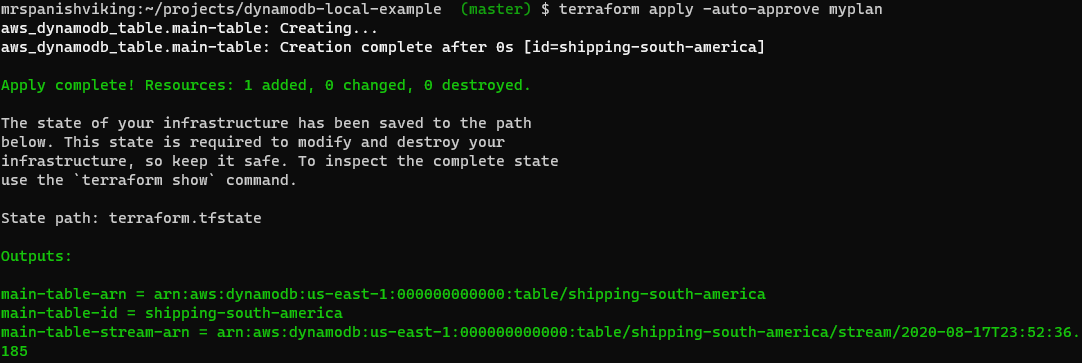

- COMMAND TO START LOCAL DYNAMODB INSTALL
- COMMAND TO START LOCAL DYNAMODB DRIVER
- COMMAND TO START LOCAL DYNAMODB CODE


DynamoDB can perform some tasks almost instantaneously, such as create/update/delete operations on tables and indexes however, the actual DynamoDB service requires more time for these tasks. delayTransientStatuses -t Causes DynamoDB to introduce delays for certain operations. If you specify -sharedDb, all DynamoDB clients will interact with the same set of tables regardless of their region and credential configuration. sharedDb -h DynamoDB will use a single database file, instead of using separate files for each credential and region. For example to create /node_modules/serverless-dynamodb-local/dynamob/ you should specify -d / or -dbPath / with a forwardslash at the end. For the path, current working directory is /node_modules/serverless-dynamodb-local/dynamob. Note that you cannot specify both -dbPath and -inMemory at once. If you do not specify this option, the file will be written to the current directory. dbPath -d The directory where DynamoDB will write its database file. When you stop DynamoDB, none of the data will be saved. inMemory -i DynamoDB will run in memory, instead of using a database file. The default setting for -cors is an asterisk (*), which allows public access.

You must provide a comma-separated "allow" list of specific domains. cors -c Enable CORS support (cross-origin resource sharing) for JavaScript. Start: sls dynamodb startĪll CLI options are optional: -port -p Port to listen on.
COMMAND TO START LOCAL DYNAMODB INSTALL
Note: This is useful if the sls dynamodb install failed in between to completely remove and install a new copy of DynamoDB local. To remove the installed dynamodb local, run: Open a browser and go to the url to access the web shell for dynamodb local. Note: Read the detailed section for more information on advanced options and configurations. Make sure above command is executed before this. To stop DynamoDB, type Ctrl+C in the command prompt window). Start DynamoDB Local and migrate (DynamoDB will process incoming requests until you stop it. Then in serverless.yml add following entry to the plugins array: serverless-dynamodb-local plugins:Īdd DynamoDB Resource definitions to your Serverless configuration, as defined here: Npm install -save serverless-dynamodb-local Start DynamoDB Local with all the parameters supported (e.g port, inMemory, sharedDb).Java Runtime Engine (JRE) version 6.x or newer.
COMMAND TO START LOCAL DYNAMODB CODE
My js code is: const connection = mysql.Is a fork of the serverless-dynamodb-local package This Plugin Requires
COMMAND TO START LOCAL DYNAMODB DRIVER
Then, after docker-compose up, running docker network ls will show: NETWORK ID NAME DRIVER SCOPE For more details about this feature, please check docker documentationĪs mentioned, it is about configuring your network between the docker containers - lambda and database.Īnother approach that worked for me (using docker-compose). Although it is quite easy but it doesn't work in all operating systems. You can always use -debug option in case you want to see more details.Īlternatively, You can also use without the hassle of playing with docker, this URL is reserved internally and gives you an access to your host machine but make sure you expose port 8000 when you start dynamodb container. Using SAM (which uses the same container lmabci/lambda): sam local invoke -event myEventData.json -docker-network myNetworkName MyFuncName More Info about lambci/lambda can be found here With the important lines being: if(_SAM_LOCAL) 'ĭocker run -rm -v "$PWD":/var/task lambci/lambda:nodejs10.x index.handler Pointed me at changing my connection code to: const AWS = require('aws-sdk')Ĭonst awsRegion = _REGION || 'eu-west-2'ĭynamoDbClient = new (options)Ĭonnect: () => dynamoDbClient || makeClient() SAM local's docker container is on 127.0.0.1 from the context of myīut they aren't on 127.0.0.1 from each other's context Machine (which is why I could interact with it) Many thanks to Heitor Lessa who answered me on Twitter with an example repoĭynamodb's docker container is on 127.0.0.1 from the context of my


 0 kommentar(er)
0 kommentar(er)
